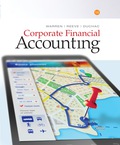
Corporate Financial Accounting
14th Edition
ISBN: 9781305887510
Author: WARREN
Publisher: Cengage
expand_more
expand_more
format_list_bulleted
Textbook Question
Chapter 11, Problem 11.3APR
Entries for bonds payable, including bond redemption
The following transactions were completed by Winklevoss Inc., whose fiscal year is the calendar year:
| Year 1. | |
| July 1 | Issued $74,000,000 of 20-year, 11 % callable bonds dated July 1, Year 1, at a market (effective) rate of 13%, receiving cash of $63,532,267. Interest is payable semiannually on December 31 and June 30. |
| Dec. 31. | Paid the semiannual interest on the bonds. The bond discount amortization of $261,693 is combined with the semiannual interest payment. |
| 31. | Closed the interest expense account. |
| Year 2 | |
| June 30. | Paid the semiannual interest on the bonds. The bond discount amortization of $261,693 is combined with the semiannual interest payment. |
| Dec. 31. | Paid the semiannual interest on the bonds. The bond discount amortization of $261,693 is combined with the semiannual interest payment. |
| 31. | Closed the interest expense account. |
| Year 3 | |
| June 30. | Recorded the redemption of the bonds, which were called at 98. The balance in the bond discount account is $9,420,961 after payment of interest and amortization of discount have been recorded. (Record the redemption only.) |
Instructions
1.
2. Indicate the amount of the interest expense in (A) Year 1 and (B) Year 2.
3. Determine the carrying amount of the bonds as of December 31, Year 2.
Expert Solution & Answer
Want to see the full answer?
Check out a sample textbook solution
Students have asked these similar questions
Accounting problem with solution
General accounting
Need help this question general accounting
Chapter 11 Solutions
Corporate Financial Accounting
Ch. 11 - Describe the two distinct obligations incurred by...Ch. 11 - Explain the meaning of each of the following terms...Ch. 11 - If you asked your broker to purchase for you a 12%...Ch. 11 - A corporation issues 26,000,000 of 9% bonds to...Ch. 11 - If bonds issued by a corporation are sold at a...Ch. 11 - Prob. 6DQCh. 11 - Bonds Payable has a balance of 5,000,000 and...Ch. 11 - Prob. 8DQCh. 11 - Prob. 9DQCh. 11 - Issuing bonds at face amount On January 1, the...
Ch. 11 - Issuing bonds at a discount On the first day of...Ch. 11 - Prob. 11.3BECh. 11 - Prob. 11.4BECh. 11 - Prob. 11.5BECh. 11 - Redemption of bonds payable A 500,000 bond issue...Ch. 11 - Prob. 11.1EXCh. 11 - Entries for issuing bonds Thomson Co. produces and...Ch. 11 - Prob. 11.3EXCh. 11 - Prob. 11.4EXCh. 11 - Entries for issuing and calling bonds; loss Hoover...Ch. 11 - Entries for issuing and calling bonds; gain Mia...Ch. 11 - Prob. 11.7EXCh. 11 - Present value of amounts due Assume that you are...Ch. 11 - Prob. 11.9EXCh. 11 - Present value of an annuity On January 1 you win...Ch. 11 - Prob. 11.11EXCh. 11 - Prob. 11.12EXCh. 11 - Present value of bonds payable; premium Moss Co....Ch. 11 - Amortize discount by interest method On the first...Ch. 11 - Amortize premium by interest method Shunda...Ch. 11 - Prob. 11.16EXCh. 11 - Prob. 11.17EXCh. 11 - Bond discount, entries for bonds payable...Ch. 11 - Prob. 11.2APRCh. 11 - Entries for bonds payable, including bond...Ch. 11 - Prob. 11.4APRCh. 11 - Prob. 11.5APRCh. 11 - Bond discount, entries for bonds payable...Ch. 11 - Prob. 11.2BPRCh. 11 - Prob. 11.3BPRCh. 11 - Bond discount, entries for bonds payable...Ch. 11 - Prob. 11.5BPRCh. 11 - Continuing Company AnalysisAmazon: Times interest...Ch. 11 - Arch Coal:Times interest earned Arch Coal, Inc. is...Ch. 11 - Aeropostale: Times interest earned Aeropostale,...Ch. 11 - Prob. 11.4ADMCh. 11 - Ethics in Action CLG Capital Inc. is a large...Ch. 11 - Prob. 11.3TIF
Knowledge Booster
Learn more about
Need a deep-dive on the concept behind this application? Look no further. Learn more about this topic, accounting and related others by exploring similar questions and additional content below.Similar questions
arrow_back_ios
SEE MORE QUESTIONS
arrow_forward_ios
Recommended textbooks for you
 College Accounting, Chapters 1-27AccountingISBN:9781337794756Author:HEINTZ, James A.Publisher:Cengage Learning,
College Accounting, Chapters 1-27AccountingISBN:9781337794756Author:HEINTZ, James A.Publisher:Cengage Learning, Excel Applications for Accounting PrinciplesAccountingISBN:9781111581565Author:Gaylord N. SmithPublisher:Cengage LearningPrinciples of Accounting Volume 1AccountingISBN:9781947172685Author:OpenStaxPublisher:OpenStax College
Excel Applications for Accounting PrinciplesAccountingISBN:9781111581565Author:Gaylord N. SmithPublisher:Cengage LearningPrinciples of Accounting Volume 1AccountingISBN:9781947172685Author:OpenStaxPublisher:OpenStax College Cornerstones of Financial AccountingAccountingISBN:9781337690881Author:Jay Rich, Jeff JonesPublisher:Cengage Learning
Cornerstones of Financial AccountingAccountingISBN:9781337690881Author:Jay Rich, Jeff JonesPublisher:Cengage Learning Financial AccountingAccountingISBN:9781337272124Author:Carl Warren, James M. Reeve, Jonathan DuchacPublisher:Cengage Learning
Financial AccountingAccountingISBN:9781337272124Author:Carl Warren, James M. Reeve, Jonathan DuchacPublisher:Cengage Learning Financial AccountingAccountingISBN:9781305088436Author:Carl Warren, Jim Reeve, Jonathan DuchacPublisher:Cengage Learning
Financial AccountingAccountingISBN:9781305088436Author:Carl Warren, Jim Reeve, Jonathan DuchacPublisher:Cengage Learning

College Accounting, Chapters 1-27
Accounting
ISBN:9781337794756
Author:HEINTZ, James A.
Publisher:Cengage Learning,

Excel Applications for Accounting Principles
Accounting
ISBN:9781111581565
Author:Gaylord N. Smith
Publisher:Cengage Learning

Principles of Accounting Volume 1
Accounting
ISBN:9781947172685
Author:OpenStax
Publisher:OpenStax College

Cornerstones of Financial Accounting
Accounting
ISBN:9781337690881
Author:Jay Rich, Jeff Jones
Publisher:Cengage Learning

Financial Accounting
Accounting
ISBN:9781337272124
Author:Carl Warren, James M. Reeve, Jonathan Duchac
Publisher:Cengage Learning

Financial Accounting
Accounting
ISBN:9781305088436
Author:Carl Warren, Jim Reeve, Jonathan Duchac
Publisher:Cengage Learning
What is Fund Accounting?; Author: Aplos;https://www.youtube.com/watch?v=W5D5Dr0j9j4;License: Standard Youtube License